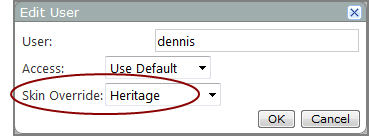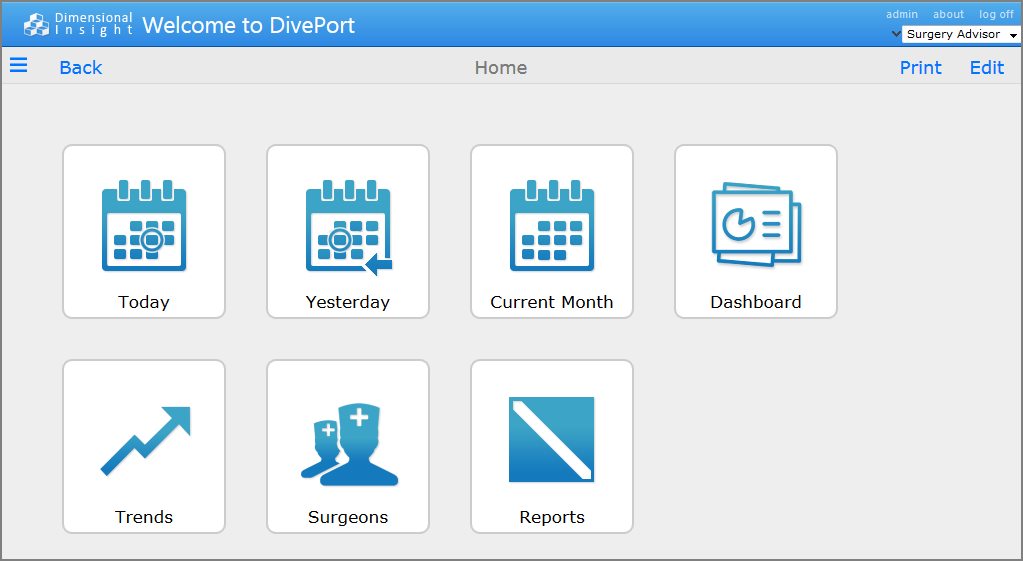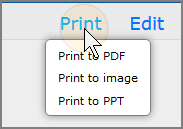Environment Settings
Each environment can use standard portal display options, or be configured to have a distinct appearance.
To customize an environment:
-
The Environments dialog box opens.
-
Click the chevron to the left of the environment that you want to customize.
The environment context menu opens.
-
Select Settings.
The Environment Settings
 dialog box opens.
dialog box opens. - Customize the settings that you want to change, and then click OK.
NOTE: An asterisk in the Environment Settings Property column indicates that the property Value has changed from the default.
Environment Settings
| Property | Description |
|---|---|
| Name |
Specifies the label that appears in the Environments list and the Environments selector that appears in the title bar when there is more than one environment on the portal. |
| ID |
Specifies the ID in the Environments list. The system defined default can be reset. |
| Title |
Specifies the text displayed in the title bar. This property can process HTML and portal variables. The default is Welcome to DivePort. |
| Skin | Specifies the Skin that gives the environment its look and feel. DivePort includes a set of built-in skin options, or you can create your own custom skins. |
| Disable User Skins |
Ignores the skin option set on the Edit User or Edit Group
|
| Interface |
Specifies the interface design for environment pages. The default is Simplified. Simplified interface
Classic interface
|
| Logo URL | Specifies an image on the web server to use as a logo in the title bar. The Dimensional Insight logo displays if this option is blank. |
| Logo Size |
Specifies the size in pixels for the logo that displays on the title bar. Set this value in the format width height. The default, auto, sizes the image to fit on the title bar. |
| Mobile Mode |
Indicates whether the environment is designed for display on a smartphone. Options are Not Mobile, and Smartphone Browser. NOTE: An environment display on an iPad functions like a 1024 x 768 display. |
| Suppress Smartphone Browser Menu |
Available in DivePort 7.1(27) and later. Bypasses the menu page when a user opens DivePort using a mobile device, and opens the page specified in the navigation link directly. The menu page can be opened by tapping the orange button at the top of the mobile device screen. NOTE: When using SSO, the page specified in the navigation link opens. |
| Chart Animations | Specifies a duration in milliseconds for chart portlets and stamp portlets to draw a chart from left to right. The default is no animation. If you use the animation feature, DI recommends setting a value of 1000. |
| Enable Self Service |
Creates a Self Service page for each user that allows them to quickly build dashboards using stamp templates. You must also specify a Default Factory Project as the next property value. |
| Default Factory Project | Specifies the Measure Factory project that is used to create self service dashboards. |
| Allow Scan Environment |
Indicates whether you can run a scan on the environment. The default is Yes. Select No to prevent scans from running. NOTE: Scans exercise all scripts associated with the portal pages, including Tunnel and Production scripts. |
| Allow PDF Printing By Default |
Allows users to print any page in the environment as a pdf file. The default is Yes. When this option is set to No, Print to PDF does not appear as a Print NOTE: Individual page settings override this environment-level setting.
|
| Allow Image Printing By Default |
Allows users to print any page in the Environment as a png file. The default is No. When this option is set to No, Print to image does not appear as a Print NOTE: Individual page settings override this environment-level setting.
|
| Allow Presentation Printing By Default |
Allows users to print any page in the environment as a PowerPoint (pptx) file. The default is No. When this option is set to No, Print to PPT does not appear as a Print NOTE: Individual page settings override this environment-level setting.
|
| Default Snap-to-Grid Pixels |
Applies the Snap-to-Grid Pixels setting to all newly created manual layout pages. The setting is blank by default (meaning no snap-to-grid). Set it to a number and then all pages created afterward will have that setting, initially. NOTE: Individual page settings override this environment-level setting. |
| Default Page Print Orientation |
Specifies a page orientation for printed pages that don't have the orientation set at the page level. NOTE: Individual page settings override this environment-level setting. |
See also:




